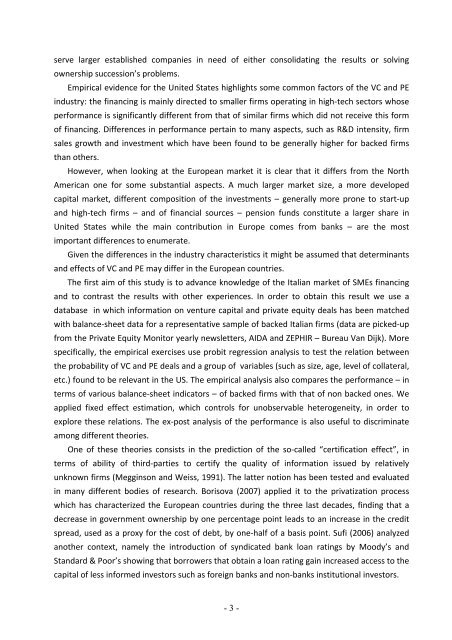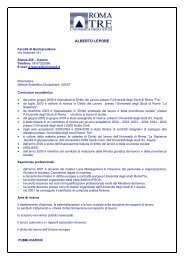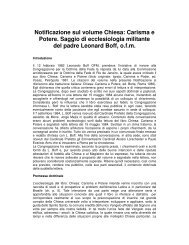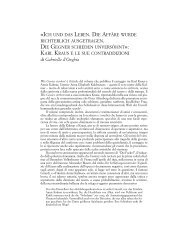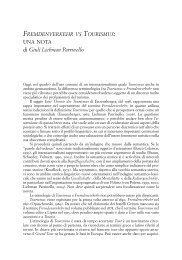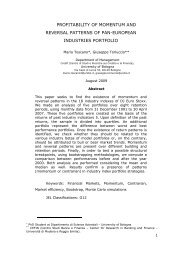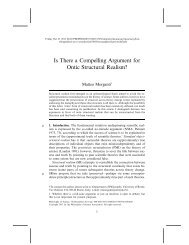Determinants and effects of Venture Capital and Private Equity ...
Determinants and effects of Venture Capital and Private Equity ...
Determinants and effects of Venture Capital and Private Equity ...
Create successful ePaper yourself
Turn your PDF publications into a flip-book with our unique Google optimized e-Paper software.
serve larger established companies in need <strong>of</strong> either consolidating the results or solving<br />
ownership succession’s problems.<br />
Empirical evidence for the United States highlights some common factors <strong>of</strong> the VC <strong>and</strong> PE<br />
industry: the financing is mainly directed to smaller firms operating in high‐tech sectors whose<br />
performance is significantly different from that <strong>of</strong> similar firms which did not receive this form<br />
<strong>of</strong> financing. Differences in performance pertain to many aspects, such as R&D intensity, firm<br />
sales growth <strong>and</strong> investment which have been found to be generally higher for backed firms<br />
than others.<br />
However, when looking at the European market it is clear that it differs from the North<br />
American one for some substantial aspects. A much larger market size, a more developed<br />
capital market, different composition <strong>of</strong> the investments – generally more prone to start‐up<br />
<strong>and</strong> high‐tech firms – <strong>and</strong> <strong>of</strong> financial sources – pension funds constitute a larger share in<br />
United States while the main contribution in Europe comes from banks – are the most<br />
important differences to enumerate.<br />
Given the differences in the industry characteristics it might be assumed that determinants<br />
<strong>and</strong> <strong>effects</strong> <strong>of</strong> VC <strong>and</strong> PE may differ in the European countries.<br />
The first aim <strong>of</strong> this study is to advance knowledge <strong>of</strong> the Italian market <strong>of</strong> SMEs financing<br />
<strong>and</strong> to contrast the results with other experiences. In order to obtain this result we use a<br />
database in which information on venture capital <strong>and</strong> private equity deals has been matched<br />
with balance‐sheet data for a representative sample <strong>of</strong> backed Italian firms (data are picked‐up<br />
from the <strong>Private</strong> <strong>Equity</strong> Monitor yearly newsletters, AIDA <strong>and</strong> ZEPHIR – Bureau Van Dijk). More<br />
specifically, the empirical exercises use probit regression analysis to test the relation between<br />
the probability <strong>of</strong> VC <strong>and</strong> PE deals <strong>and</strong> a group <strong>of</strong> variables (such as size, age, level <strong>of</strong> collateral,<br />
etc.) found to be relevant in the US. The empirical analysis also compares the performance – in<br />
terms <strong>of</strong> various balance‐sheet indicators – <strong>of</strong> backed firms with that <strong>of</strong> non backed ones. We<br />
applied fixed effect estimation, which controls for unobservable heterogeneity, in order to<br />
explore these relations. The ex‐post analysis <strong>of</strong> the performance is also useful to discriminate<br />
among different theories.<br />
One <strong>of</strong> these theories consists in the prediction <strong>of</strong> the so‐called “certification effect”, in<br />
terms <strong>of</strong> ability <strong>of</strong> third‐parties to certify the quality <strong>of</strong> information issued by relatively<br />
unknown firms (Megginson <strong>and</strong> Weiss, 1991). The latter notion has been tested <strong>and</strong> evaluated<br />
in many different bodies <strong>of</strong> research. Borisova (2007) applied it to the privatization process<br />
which has characterized the European countries during the three last decades, finding that a<br />
decrease in government ownership by one percentage point leads to an increase in the credit<br />
spread, used as a proxy for the cost <strong>of</strong> debt, by one‐half <strong>of</strong> a basis point. Sufi (2006) analyzed<br />
another context, namely the introduction <strong>of</strong> syndicated bank loan ratings by Moody’s <strong>and</strong><br />
St<strong>and</strong>ard & Poor’s showing that borrowers that obtain a loan rating gain increased access to the<br />
capital <strong>of</strong> less informed investors such as foreign banks <strong>and</strong> non‐banks institutional investors.<br />
- 3 -


